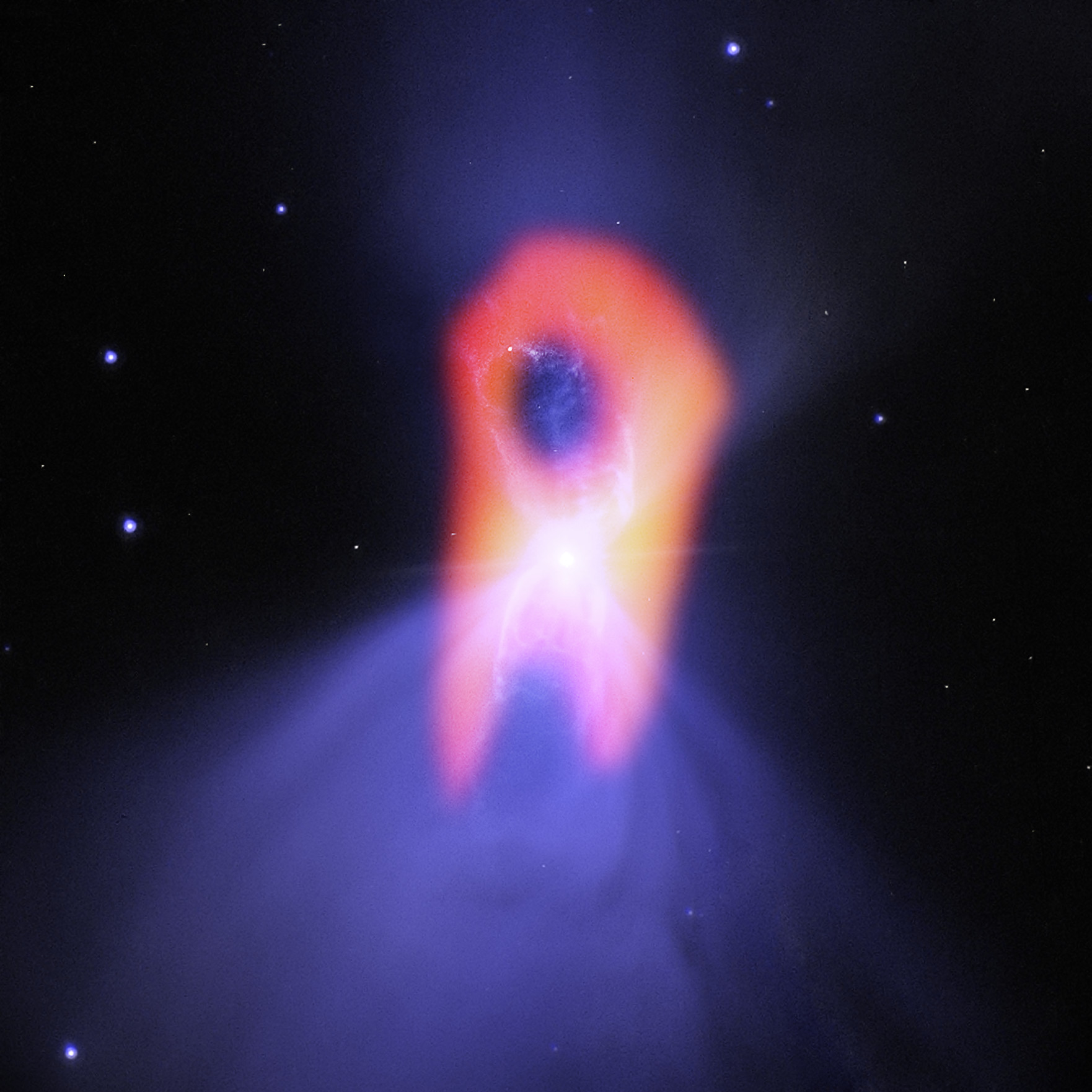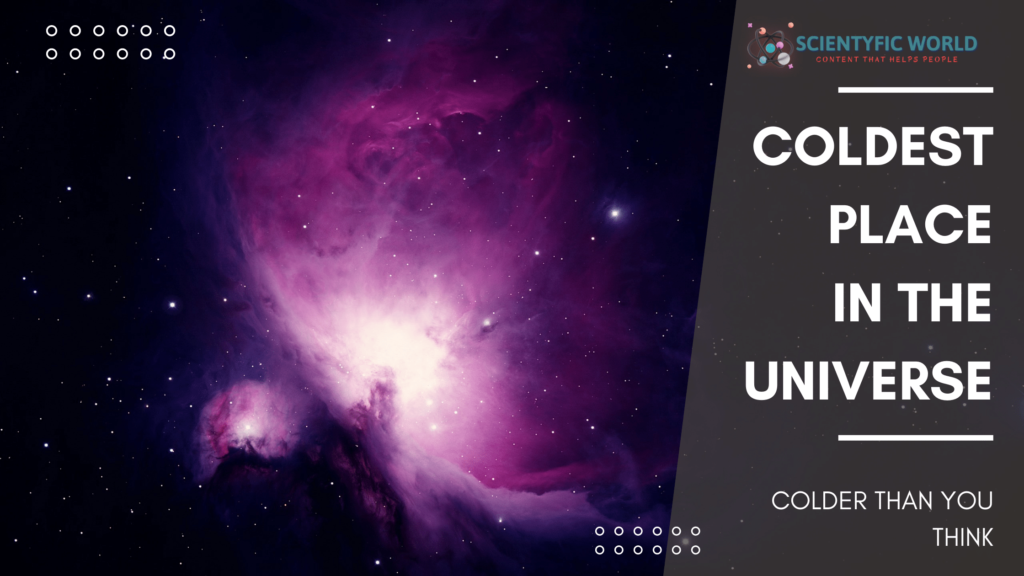Our universe is incredibly vast and diverse. From the beginning, Scientists are trying to study it more deeply. As a result, they observed things that always amazed us. Like blackholes, clusters, galaxies, and nebulas. Scientists have discovered the darkest place in the universe, the hottest place in the universe, Earth-like planets and etc. However, they also discovered one place, which takes the title of the coldest place in the universe, and that is the Boomerang Nebula.
Boomerang Nebula is one of the coldest places in the universe. It is a nebula, which is a cloud of dust and gas, located in the Centaurus constellation. The temperature in the Boomerang Nebula is only about -272o Celsius, which is only about 1 degree above absolute zero. This makes it the coldest known place in the universe.
But what is Nebula?
Nebulas are giant clouds of dust and gas in space. They are often called “stellar nurseries” because they are where stars are born. Nebulas are made of hydrogen gas and dust. They are often very colorful because of the way the gas and dust reflect light. Some nebulas are so big that they can be seen with the naked eye. The Orion Nebula, for example, is visible to the naked eye as a fuzzy patch in the Orion constellation.
Here are some facts about Nebula:
Nebulas are often found near star clusters or molecular clouds. This is because star formation requires dense pockets of gas and dust. The most massive stars form in the densest nebulas.
Nebulas can be categorized by their shape. Some common types of nebulas are planetary nebulas, diffuse nebulas, reflection nebulas, and emission nebulas.
- Planetary nebulas are round or elliptical in shape. They are created when a star expels its outer layers of gas and dust. The gas and dust form a “shell” around the star.
- Diffuse nebulas are large, bright, and have no specific shape. They are often irregular in shape. Diffuse nebulas are created by the shockwaves from supernova explosions.
- Reflection nebulas are blue in color. They are created when starlight reflects off of dust particles. The dust particles must be very fine in order to reflect the light.
- Emission nebulas are red in color. They are created when electrons are excited by ultraviolet light. The electrons then emit light.
Nebulas are important to astronomers because they help us understand how stars are born and how they die. By studying nebulas, we can better understand our place in the universe.
Now, coming back to the Boomerang Nebula.
Discovery:
The Boomerang Nebula was first discovered in 1995 by astronomers using the European Southern Observatory’s Very Large Telescope. They were looking for evidence of star formation, but what they found was something quite different. The nebula appeared to be “moving away from us at a speed of about five kilometers per second.”
It wasn’t until 2003 that the Boomerang Nebula was found to be the coldest place in the universe. This was determined by using the Atacama Large Millimeter Array, which is a group of radio telescopes in Chile. The astronomers were able to measure the temperature of the dust in the nebula and found it to be about -272 degrees Celsius.
How Boomerang Nebula was formed?
When star formation begins, dense pockets of interstellar gas and dust begin to collapse under their own gravitational pull. As the matter collapses, it begins to spin and flatten into a disk-like shape. This rotating disk of material is known as a protoplanetary disk, and it is from this disk that new planets and moons form.
As the disk of material continues to collapse, it becomes increasingly dense and hot. In the center of the disk, a protostar begins to form. The protostar continues to grow in mass as more and more material falls onto it. At the same time, the protostar begins to heat up and its core starts to fuse hydrogen atoms together, creating helium. This process of nuclear fusion releases a tremendous amount of energy, and the protostar begins to shine.
As the protostar continues to grow in mass, its gravity becomes stronger and its core becomes even hotter. Eventually, the protostar becomes so massive and hot that it ignites a violent starburst, blowing much of the surrounding material away. This material forms an expanding cloud of gas and dust known as a nebula.
The Boomerang Nebula is a nebula that was formed in this way. It is located in the constellation Centaurus, and is one of the coldest and densest nebulae that is known. The Boomerang Nebula gets its name from its shape, which resembles a boomerang.
The Boomerang Nebula is thought to be about 1,000 years old. It is about 5 light-years across, and is about 5,000 light-years from Earth. The nebula is composed of two lobes of gas and dust that are expanding away from each other. The lobes are expanding at a rate of about 30 kilometers per second.
The Boomerang Nebula is one of the most interesting and complex nebulae known. It is a beautiful example of how star formation can shape the material in the interstellar medium.
Why did it name Boomerang Nebula?

The Boomerang Nebula is so named because of its appearance in ground-based photographs. It was first observed in 1980 with the Anglo-Australian Telescope (AAT) as part of a study of very young planetary nebulae. The AAT image showed the central star surrounded by a ring of nebulosity that appeared to be symmetrical about the star. In 1995, the Hubble Space Telescope (HST) took a more detailed image of the Boomerang Nebula, which showed that the ring was actually two lobes of nebulosity, pointing away from each other.
The Boomerang Nebula is an interesting object to study because it provides insight into the evolution of planetary nebulae. It is also one of the few objects in the Universe that has been observed to have a negative temperature.
Where actually this Nebula belongs?
The Boomerang Nebula is located in the constellation Centaurus, about 5,000 light-years from Earth. It is thought to be the result of a star with a mass of about 1-2 times that of the Sun. The star is in the process of shedding its outer layers of gas and dust, which are being blown away by the star’s ultraviolet radiation. The result is the distinctive bipolar (two-lobed) shape of the Boomerang Nebula.
Centaurus constellation:

Now talking about the Centaurus constellation, it is one of the largest constellations in the sky and is easily recognizable (thanks to its bright stars). It is home to some of the brightest stars in the night sky, including the red giant Alpha Centauri and the blue-white star Rigil Kentaurus. The constellation also contains the famous globular cluster Omega Centauri, one of the brightest and most massive clusters in the sky.
Centaurus is located in the southern sky and is best seen in the months of February and March. It is a large constellation, covering an area of over 1,000 square degrees. It is located next to the constellations of Lupus, Hydra, and Vela.
The constellation Centaurus is named after the centaur, a creature from Greek mythology that was half-man and half-horse. The centaur Chiron was a famous teacher and healer and was said to be the son of the god Apollo.
Now coming to our main question,
Why this is the Coldest Place in the Universe?
The coldest known place in the universe is actually not the Boomerang Nebula. That honor goes to a place called the “Cosmic Background Explorer” or COBE for short. COBE was a satellite that was launched in 1989 and it measured the background radiation of the universe. The background radiation is the afterglow of the Big Bang and it has a temperature of about -270 degrees Celsius.
So why is the Boomerang Nebula the coldest known place in the universe?
One theory is that the nebula is so cold because it is so far away from us. The Boomerang Nebula is about 5,000 light-years away from Earth, which means that the light from the nebula has taken 5,000 years to reach us. That means that we are seeing the nebula as it was 5,000 years ago.
Another theory is that the Boomerang Nebula is cold because it is very dense. The nebula is made up of dust and gas that is about one hundred times denser than the average density of the universe. This means that the Boomerang Nebula is actually collapsing in on itself.
Another theory says that the Boomerang Nebula is so cold because it is expanding at a rate of around 100 kilometers per second, which causes the gas and dust to cool as it expands. This expansion also causes the nebula to emit a very faint red light, which is why it is sometimes known as the Red Rectangle Nebula. The Boomerang Nebula is not the only cold place in the universe, but it is certainly the coldest that has been discovered so far.
Either of these theories, the Boomerang Nebula is an amazing place. It is the coldest known place in the universe and it is also one of the most fascinating places to study.
Hope you like this article!
There are many other interesting and fascinating places in the universe, and we hope you will continue to explore them with us!







